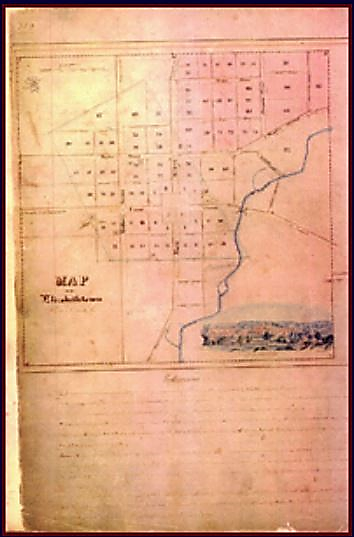

The History of Hardin County
The land area we know today as Hardin County began to be explored during the eighteenth century.
The first recorded exploration occurred in 1766 by Col. John Smith while on a hunting expedition. In 1776, a group known as Shane, Sweeney and Co., led by Samuel Pearman, explored the area in search of a possible settlement landing in the area known today as West Point at the confluence of the Ohio and Salt Rivers.
However, the approaching winter and several Indian attacks sent them back to Virginia. Squire Boone, brother of Daniel Boone, explored Hardin County many times during the 1770s, but no permanent settlement was made until 1780.
During that year, Col. Andrew Hynes, Capt. Thomas Helm and Jacob Vanmeter each built a fortress about one mile of each other near the area known today as Elizabethtown. They named the new settlement Severn’s Valley. By the following year, Severn’s Valley was home to 17 families.

With the new settlement there was a need for a church and Severn’s Valley Baptist Church was constituted with 17 members on June 17, 1781. This church is the oldest Baptist congregations with continuous existence west of the Allegany mountains.
During this period, Hardin County was still a popular hunting area for many Indian tribes. These Indians would arrive in the spring to plant their corn and return in the fall to harvest their crop and hunt.
The final major skirmish between the white settlers and the Indians occurred in 1792. Severn’s Valley was attacked by 15 Indians, resulting in the deaths of two women and five children, slain livestock and several demolished cabins. Fifteen men led by Patrick Brown tracked down the attackers and killed all but one of them.
Hardin County was established in November 1792 and became an official county on Feb. 20, 1793. The county was named after Col. John Hardin, an Indian fighter who had been killed by the Indians while on a peace mission with the Miami tribes in Ohio.
The first courthouse was constructed at a cost of $220 in 1795.
Original Hardin County encompassed 4,000 square miles. All or part of 12 other counties have been formed from this original area. Breckinridge, Daviess, Grayson, Green, Hancock, LaRue, Meade and Ohio counties were formed from original Hardin County, as well as parts of Butler, Edmonson, Hart, Henderson and McLean counties. The boundaries of the original area were the Ohio, Salt, Rolling Fork and Green rivers.
Today, Hardin County consists of 616 square miles and is the fourth largest county in Kentucky in terms of land area and population.
Merchandising establishments began to appear in the county around 1795. Among these businesses were a combination of taverns, stables and inns, which were called ordinaries. These ordinaries were about a one-day horse or carriage ride apart with the purpose of serving the needs of the traveler. Some of the locations for these establishments later became thriving communities that continue today. They are Hardin’s Ford or Hardinsburg, Vienna of Falls of Rough and Ohiopiomingo or Rockhaven.
In a mix of public and private interest that we would find peculiar today, the county government regulated prices in these ordinaries to protect the traveling public in the vacuum of competition. Some of the prices that the cou rt determined to be fair in 1793 were: $0.15 for a half pint of whiskey; $0.06 for the lodging for one person for one night; and $0.25 for a meal.
Abraham Lincoln was born in what was then part of Hardin County and now LaRue County on Feb. 12, 1809. He and his family left Kentucky in the fall of 1816.
Abraham Lincoln and his family left a heritage in our community that remains strong today. In fact, Hardin County had many important persons of American history play some role in the county over time. For example, around 1800 the county attracted some of the best and brightest young lawyers of the day to practice in our courts arguing the various positions offered by our poorly written land title laws. Many lawsuits arose when clear titles could not be established. The future 15th president of the United States, James Buchanan, was one of those lawyers.
In October, 1861, Union Gen. William Tecumseh Sherman was declared insane at his headquarters at Fort Duffield, West Point by the secretary of war, Simon Cameron, when he gave his estimation that he would need approximately 200,000 troops to hold the line for the union in Kentucky. History tells us that Sherman’s estimation was correct and the secretary of war was the one who was out of touch with reality.
Later in the war, Confederate General John Hunt Morgan brought approximately 4,000 troopers to Hardin County while conducting the “Christmas Raid” his most successful raid of the war in December 1862. He began his operations at Upton destroying the L&N railroad Bridge at Bonnieville and then destroying the tracks from that point north. He paused to defeat the Union garrison at Elizabethtown and the next day moved to destroy the object of the raid: two huge railroad trestles located on Muldraugh’s Hill. Morgan destroyed the trestles and left Hardin County slipping away across the Rolling Fork River while another Union force pursued him in vain.
After the war, Union Gen. George Armstrong Custer spent three years in Elizabethtown before he made his final battle at the Little Big Horn. In 1904, militant temperance leader Carry Nation shed blood for her cause after being clubbed in Elizabethtown by a saloon owner who disagreed with her view of alcohol.
This is not a complete list, but it gives you an idea of the colorful and interesting persons who have lived in the county at one time or another.
In 1796, James Young officially established West Point by constructing a log structure and laying out lots for development. A year later, he constructed Young’s Inn that continues to stand today.
In 1806, the first brick courthouse was constructed to replace the log structure, and Hardin Academy, the county’s first schoolhouse, was built. Other historical schools include the Cecilian College, Lynnland College, Hambleton College and Bethlehem Academy.
The Elizabethtown Community College – now known as Elizabethtown Community and Technical College –was established in 1964 and is very much a part of our growing community today. The first post office in the county was built March 1, 1819, at West Point. Elizabethtown built its first post office the following year.
In 1818, the Union Bank, the county’s first bank, was organized with $100,000 in capital stock. It later closed about the time the Civil War began, leaving the county without a bank. After the war, Thomas Polk & Co. opened another bank. This was followed in 1883 by the opening of the two banks: the Bank of Elizabethtown and the First National Bank.
A building trend began about 1800 in Hardin County due to a stipulation placed on each lot that required a home to be built within two years of purchase. About this time, we see the “round log” cabins with dirt floor being replaced by hewed log houses. The public began to exhibit a general desire for better housing, which included glass windows and wooden floors.
Improved housing really got a boost in the county when Hezekial Smallwood came to Hardin County from Virginia about 1802 and began making bricks on Buffalo Creek. By 1869, it was estimated that he had made the bricks for half of all the homes in Elizabethtown.
The first newspaper in the county was the Western Intelligencer, which began in 1826. Of course, a respectable county has more than one source of information, so the second newspaper, the Kentucky Statesman, began printing in 1828.
In 1826, the Kentucky General Assembly established a company to construct an artificial or paved road from Louisville to West Point to Elizabethtown and on to the Kentucky line to eventually connect with Nashville. This road permitted travel and trade between the two states even in wet weather that usually bogged down horses and carriages until the road dried.
As for public transportation, beginning in 1828 the people of the county were fortunate to have access to a stagecoach that ran daily between Louisville and Nashville. In 1854, the most important economic event of the 19th century came to Hardin County with the charter of the Louisville and Nashville Railroad. Elizabethtown native and twice governor of the Commonwealth John L. Helm served as board chairman of the L&N in the developmental stages of the railroad. The first train ran Oct. 27, 1854.
Around 1850, a group of settlers found a nice spot in northern Hardin County tangled with wild grapevines. They appropriately named the new settlement along the Otter Creek: Vine Grove. The original location of the settlement was about a mile west of its present location at the intersection of the Paducah and Louisville Railroad and KY 144. The town moved to its present location in the late 1860’s to take advantage of the newly constructed line of the L&N Railroad. Vine Grove experienced two setbacks in 1905 and 1908 when the town was destroyed by fire.
In 1870, Samuel Haycraft, Jr. pronounced the second Hardin County courthouse as “decidedly the poorest and most uncomfortable courthouse in the state.” In light of his views and political influence, a new one was built in 1873 after the Kentucky General Assembly authorized the Hardin County Court to levy a tax for its construction.
In 1918, the second most important economic event occurred when 1/12 of the county was transferred to the United States Government to establish Camp Henry Knox. It served as one of four artillery training centers after the U.S. became involved in World War I. The original 10,000 acres was expanded to 100,000 acres and became Fort Knox on Jan. 1, 1932. Fort Knox is home of the U.S. buillion depository, more commonly known as the gold vault.
Opportunity came in the wake of the establishment of Camp Knox as Col. Horace McCullum bought some land along Dixie and began selling lots to the military population. The community eventually incorporated in 1956 and was named Radcliff after Maj. Radcliffe, the supervisor of the Corps of Engineers who constructed Camp Knox.
In December 1932, the third Hardin County courthouse burned. Although all of the county records were saved, it was 15 months before a new courthouse could be constructed. This courthouse is used today by the Hardin County Government. The fifth Hardin County courthouse now stands next to Valley Creek on U.S. 31W.
The final two crowning events for the county are the dedication of Hardin Memorial Hospital in February 1954 and the July 14, 1965, opening of the Kentucky Turnpike between Elizabethtown and Louisville. We have seen so many wonderful public works projects and development in our county, it is difficult to limit the list of accomplishments to those mentioned above. But suffice it to say that Hardin County is a healthy growing community with a foundation in the past and looking toward a bright future.






